P
Pinball News
Guest
MULTIMORPHIC VISIT 2023
Pinball News
Back in 2019 we paid a visit to the Multimorphic factory in Round Rock, Texas. Since then, much has changed, both with the company itself and with the pinball industry as a whole, but the intervening four years have been good for Multimorphic, with new games launched, new personnel on board, and the P3 platform becoming even more widely adopted.
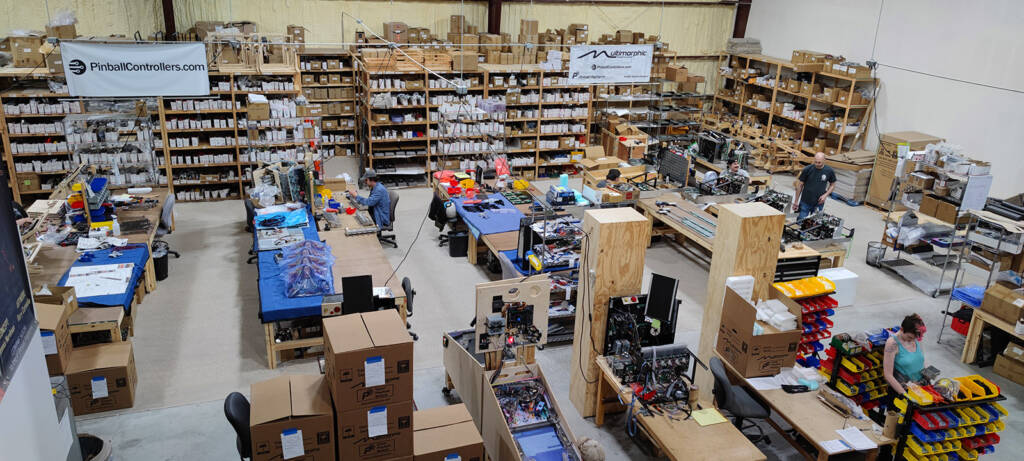
The Multimorphic playfield and machine assembly area
As the business has grown, so has the company – literally. They now occupy around twice the factory space they did in 2019, taking over the adjacent unit for a woodworking shop, additional office space and an area used to display previous and current generations of the P3 pinball platform.
Pinball News has followed the evolution of the P3 right from its earliest days. Here are a few of those reports:
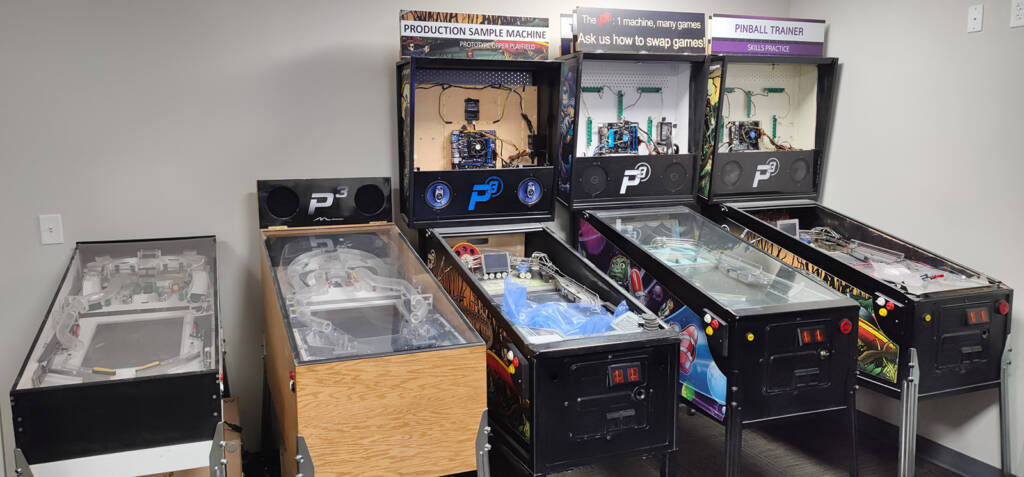
The evolution of the P3 pinball platform
In addition to these early prototypes, the expanded space allows for ten P3 machines to be set up to showcase the range of games and playfield modules now available for the platform.
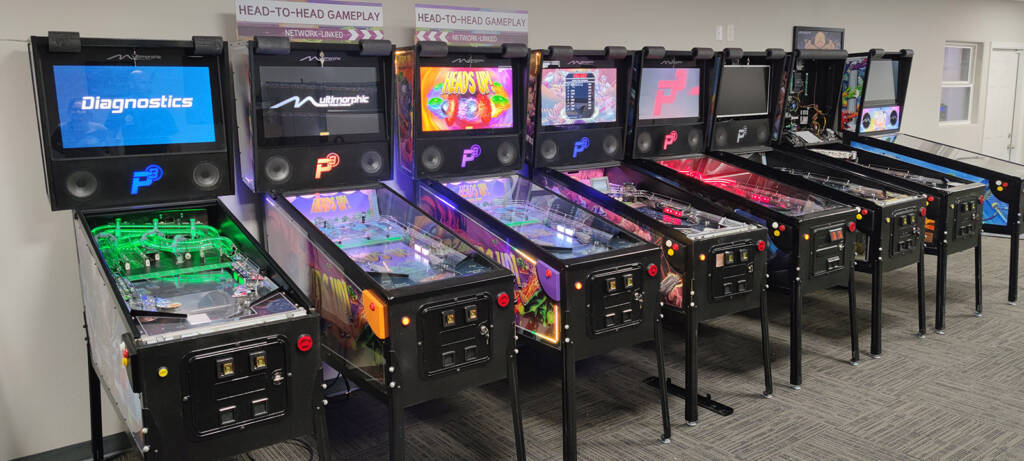
The P3 with various playfield modules and game packages
It’s worth noting how two of these machines featured prototype side panel RGB lighting strips around the backbox and cabinet artwork decals.
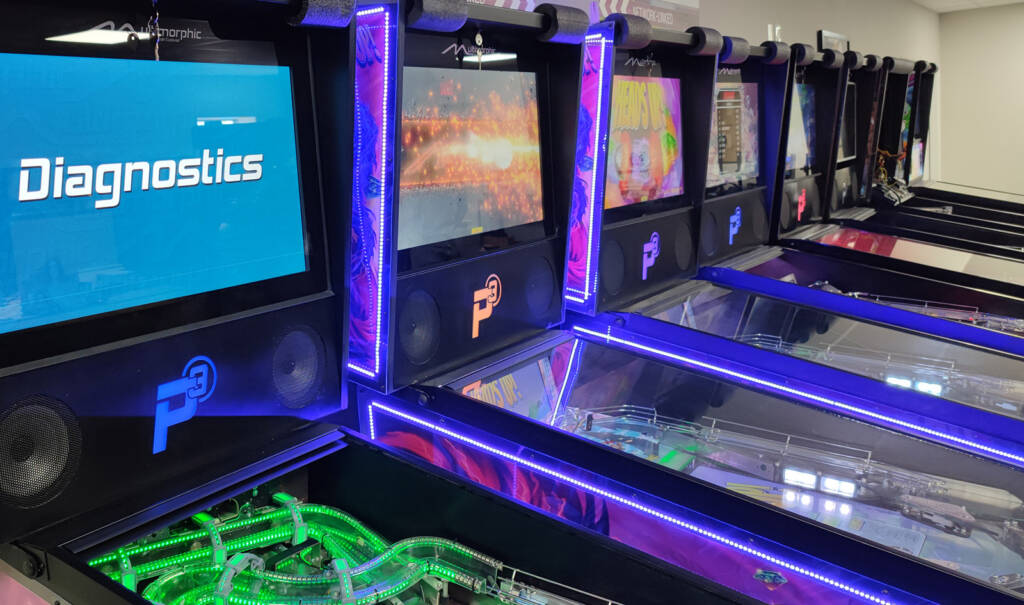
Backbox and cabinet RGB lighting effects
For protection, these animated LED strips fit under the artwork protectors available from the Multimorphic store to protect and secure the magnetic decals
When we visited, most of these P3s were about to be packed up and taken on a three-hour drive up to Frisco for the Texas Pinball Festival. There, they would be joined by two examples of the company’s latest release, Final Resistance.
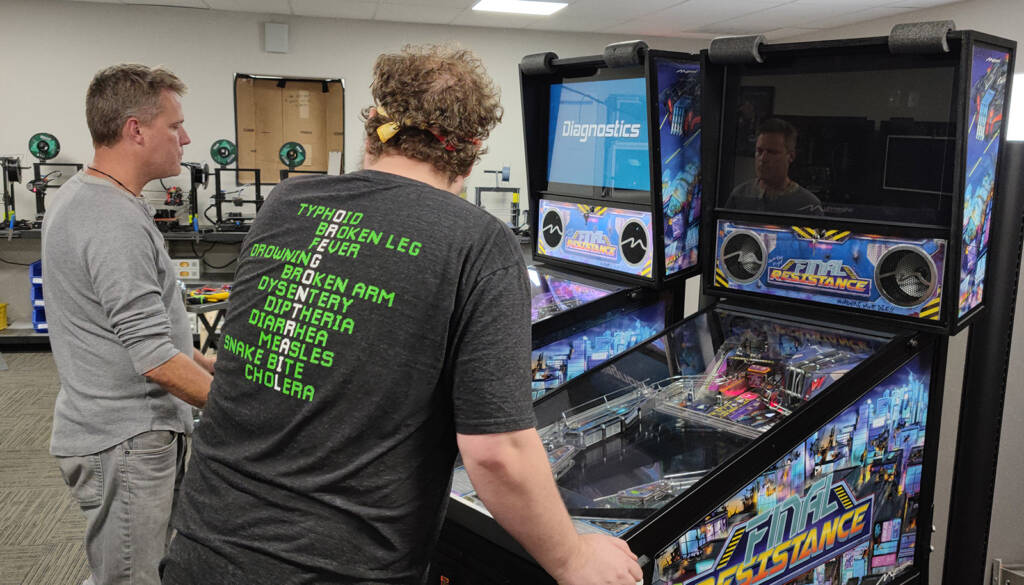
Two of the latest Final Resistance games
The additional space is also home to a row of 3D printers which are used to produce some of the generic plastic parts used in the game such as speaker and fan housings, and various mounting brackets.
Multimorphic head, Gerry Stellenberg, told us it makes sense to 3D print some of their more common parts as they can be made on-demand, don’t take up storage space, and the price is often cheaper than ordering in small relatively quantities from plastics manufacturers more used to orders in the tens of thousands.
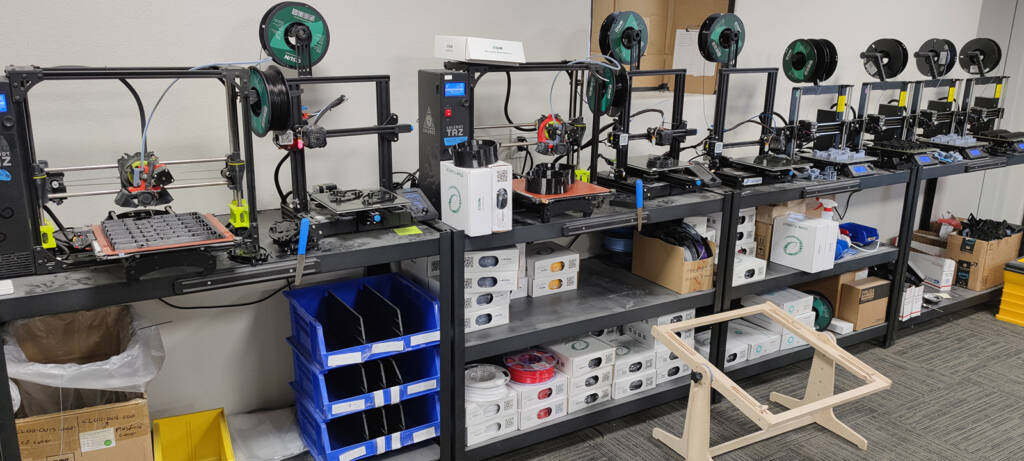
3D printers at work
The other part of the extended factory space is taken up with the woodworking shop where playfields, cabinets, backboxes, toppers and interior wooden parts are cut, along with other wooden parts such as the rotisseries used during playfield assembly.
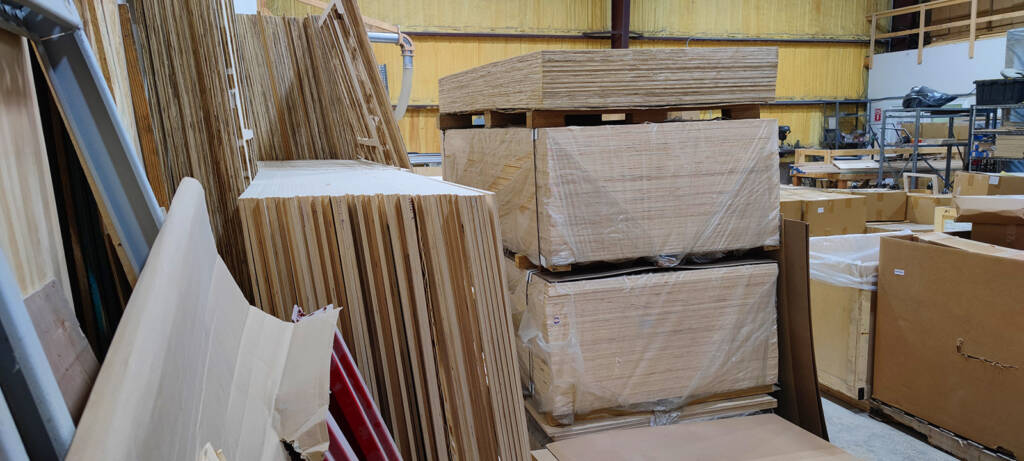
Stacks of wood sheets in the woodworking shop
The CNC router cuts the sheets into the required parts.
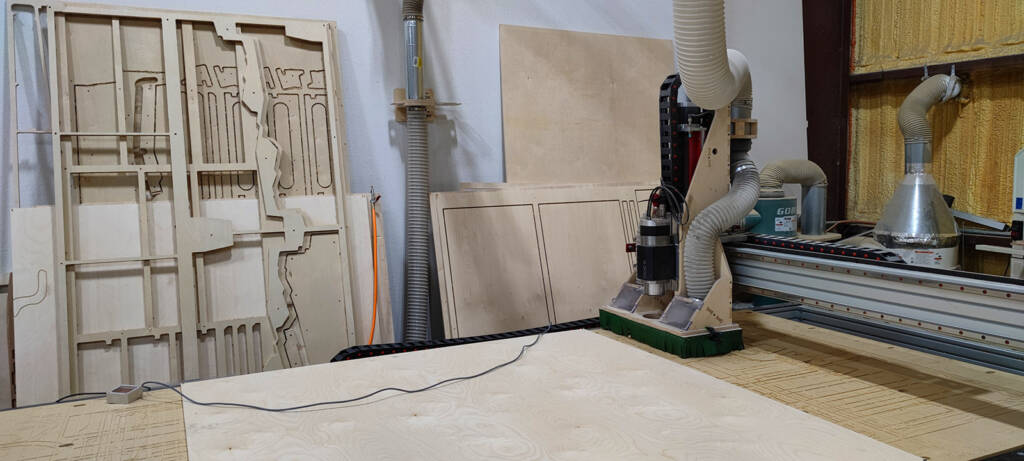
The CNC router cutting playfields and cabinet parts
While they were once made of metal, the cabinets and backboxes for the P3 now use a more-traditional wooden construction, although they also feature a unique playfield slide system providing multiple points where the playfield can be rested or raised to access the underside.
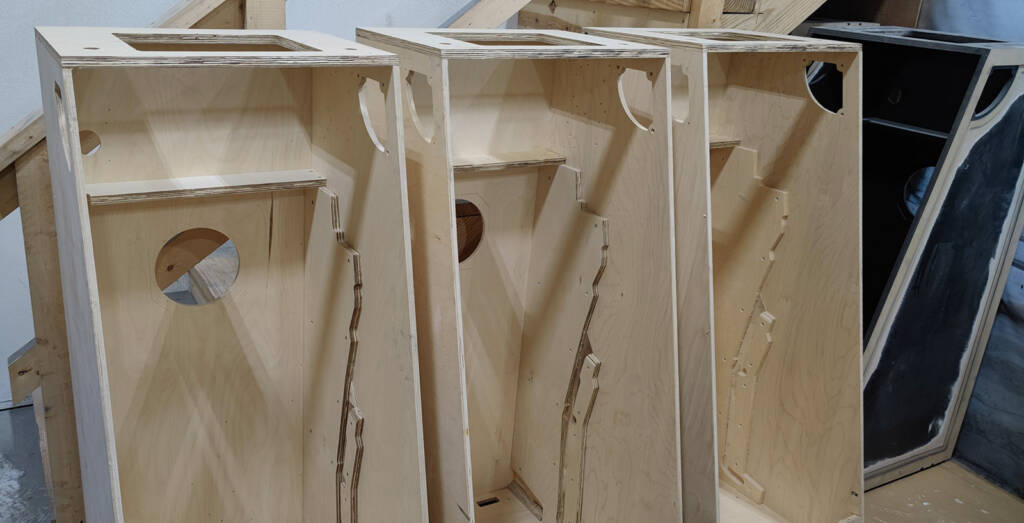
Cabinets waiting to be painted
Completed cabinets and backboxes then head into the spray booth to be painted black.
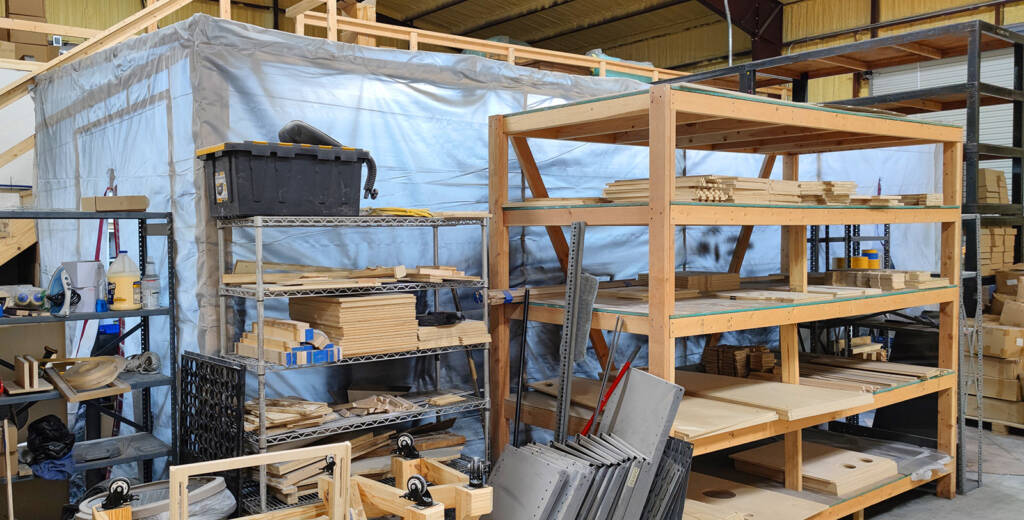
The spray booth
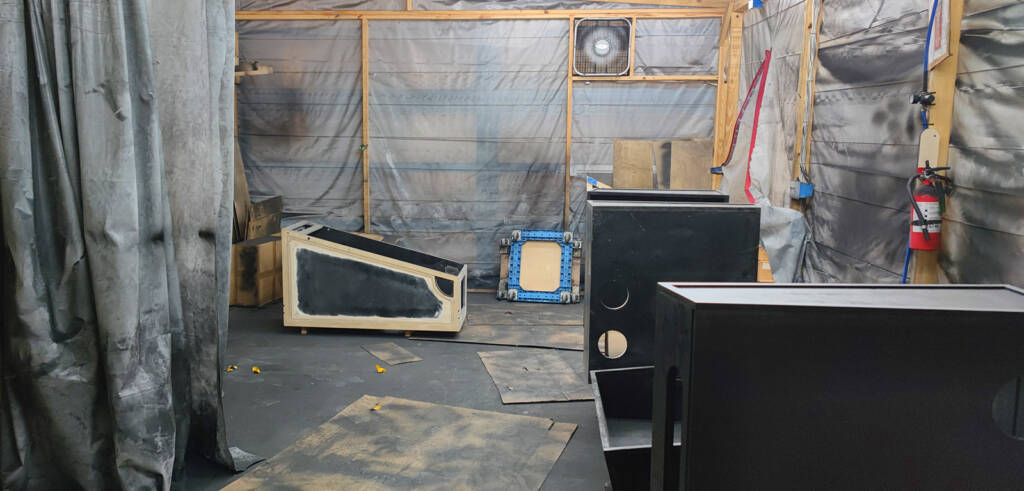
Cabinets being painted black inside the spray booth
The area above the offices and showroom in the expansion unit is not wasted, as it is used for parts storage for the company’s expanding range of different titles.
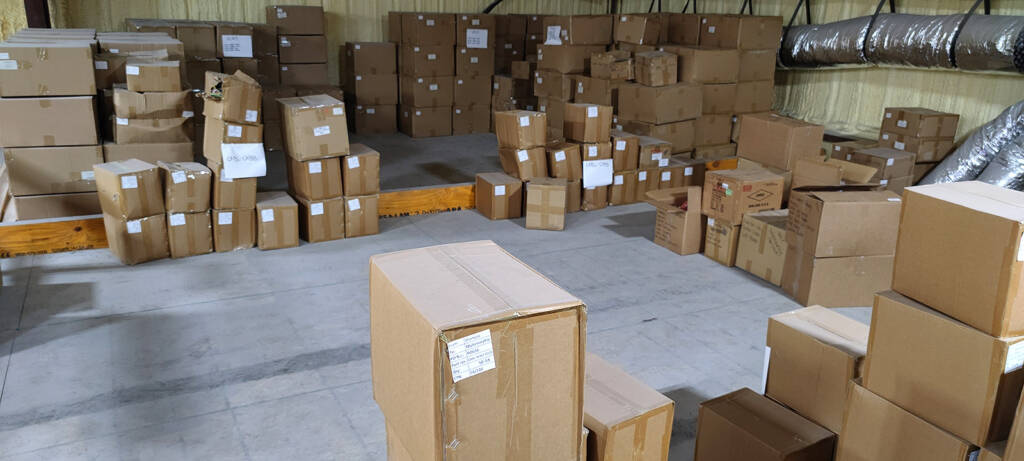
Boxes of parts for games in storage on the upper floor
Meanwhile, back in the original factory space, construction of playfield modules and entire P3 machines is underway.
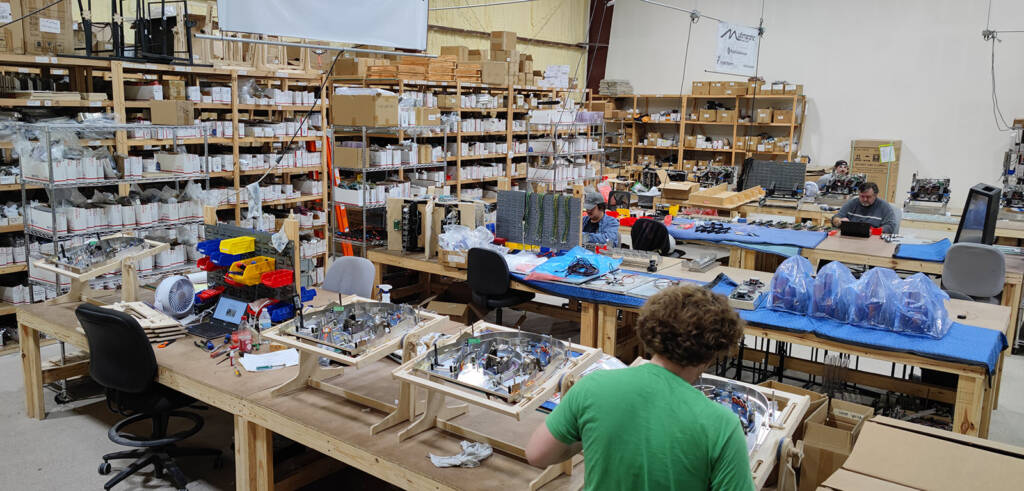
The playfield manufacturing area
Playfield modules for the company’s Weird Al’s Museum of Natural Hilarity game were being made during our visit.
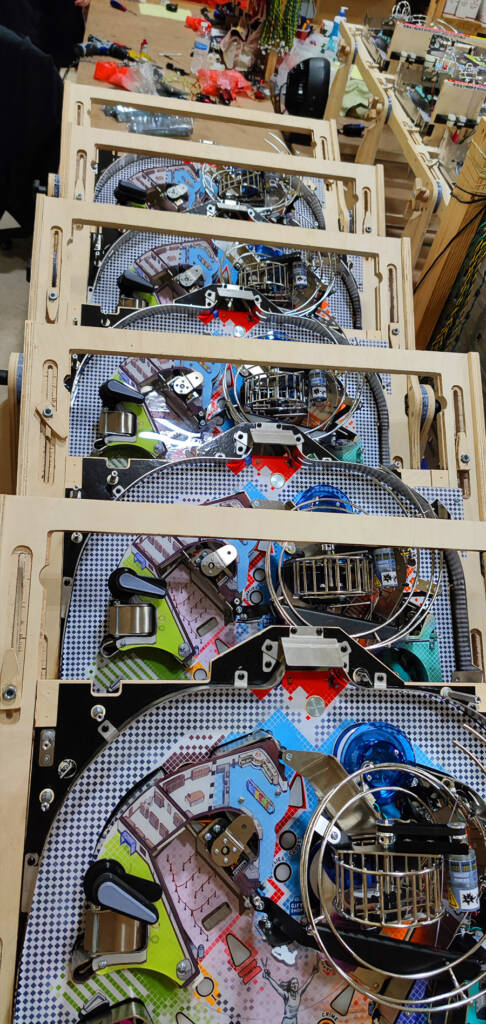
Weird Al’s Museum of Natural Hilarity playfield modules
With a backorder time of up to 6 months for new game kits, there would be plenty more Weird Al game kits produced before Final Resistance goes into production, starting in May.
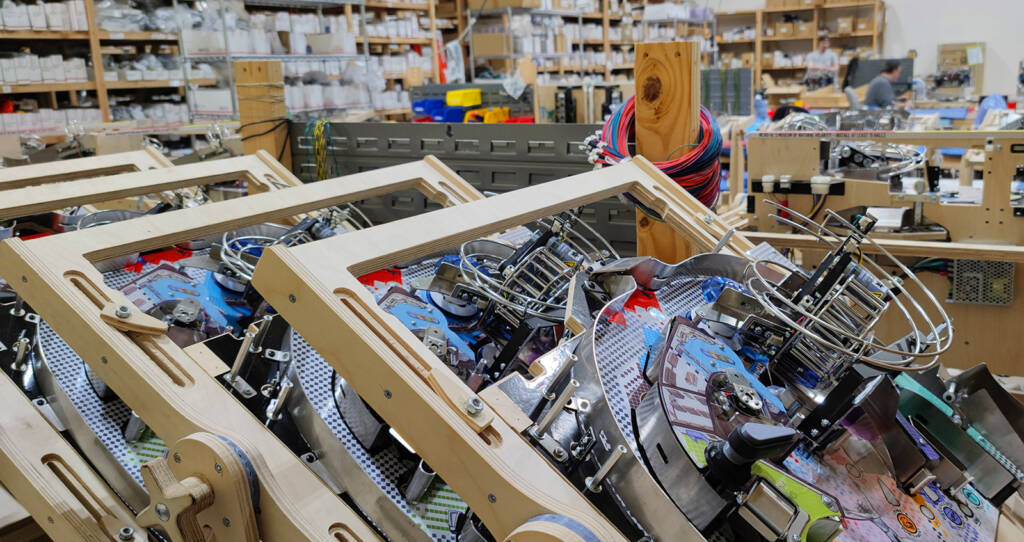
Manufacturing playfield modules
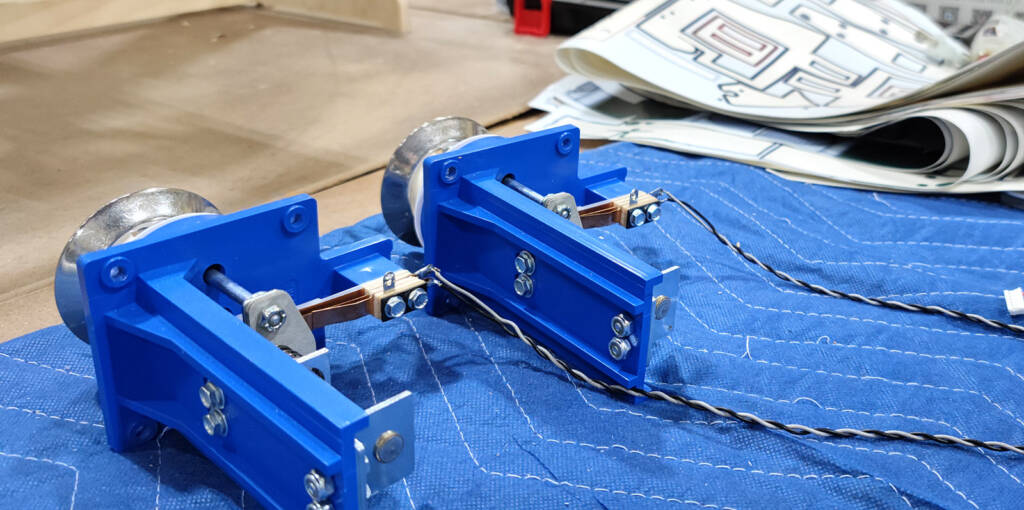
Assembling Multimorphic’s pop bumper modules
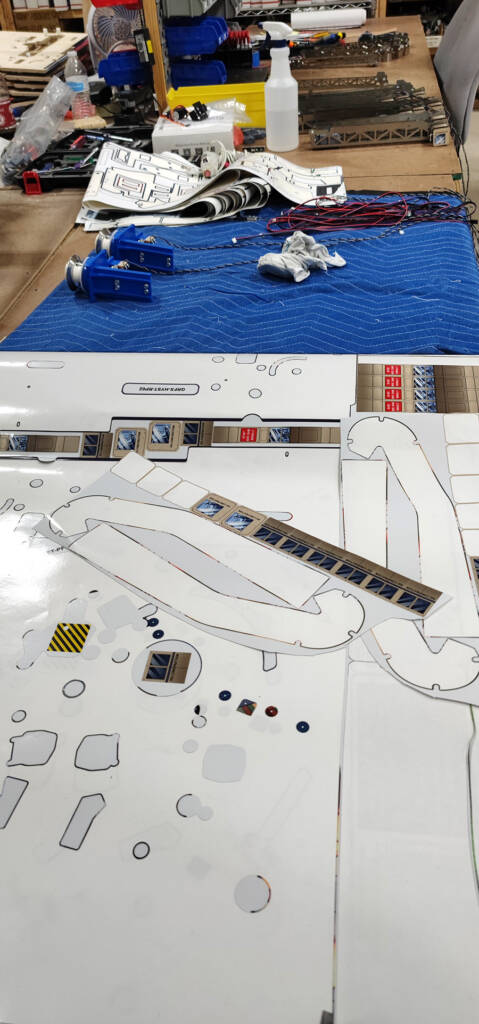
Applying playfield decals
Along with playfield modules, software and artwork, many new games also come with the option of a dedicated topper. The animated Weird Al topper has been especially well-received.
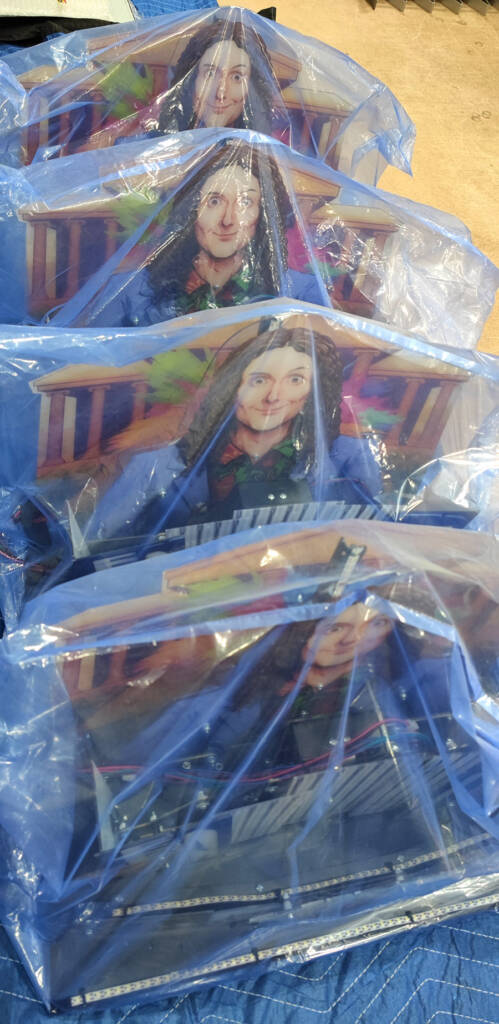
Completed Weird Al toppers
At one time, the base P3 machines were built by an external contractor with the individual game modules built in-house. Although the ability to make their own cabinets is a more recent development, they have been building the main playfield chassis (which slides into the cabinet) at the Multimorphic factory for several years.
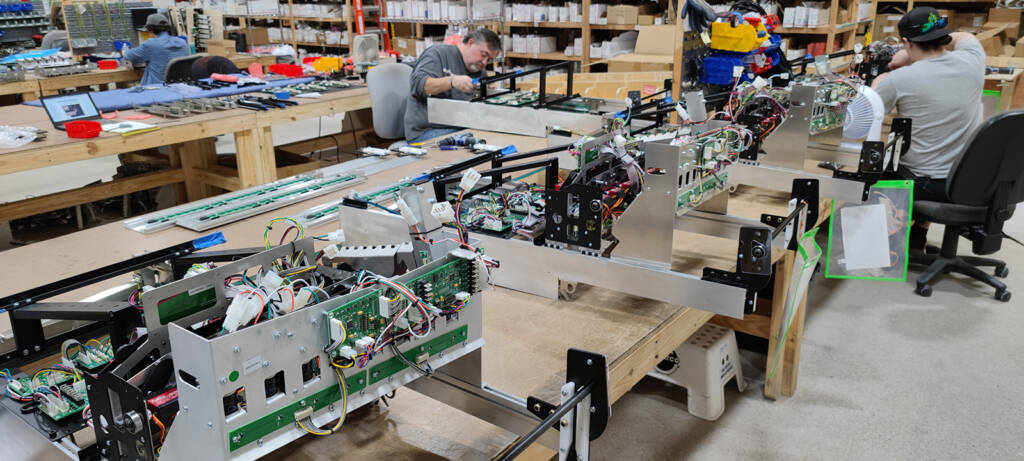
Assembling complete P3 machines
The main playfield uses a modular system where different modules such as the main flippers, the playfield monitor, the upper flipper and the side targets all slide in on rails. This allows the correct functionality of each module to be tested in isolation before it is slid into position in the main playfield chassis to be tested again as part of the whole machine.
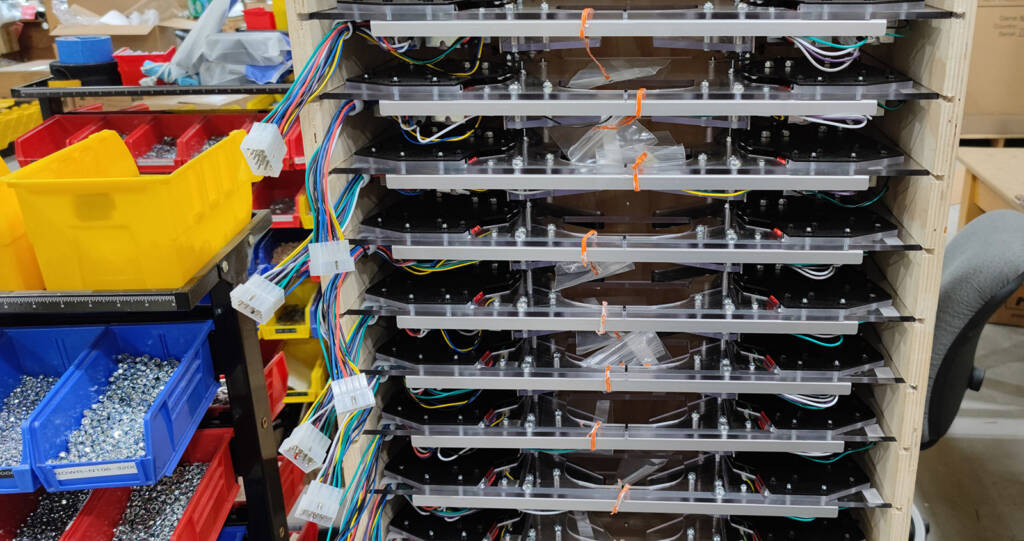
A rack of flipper modules
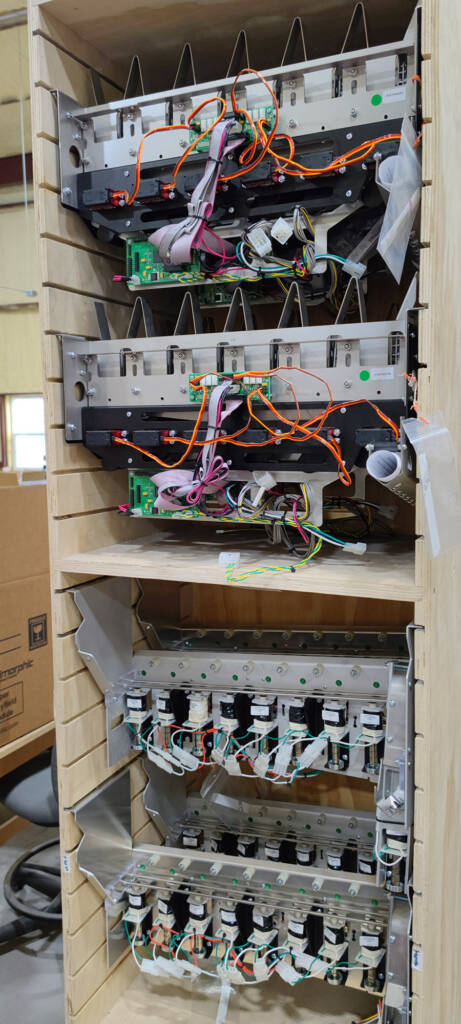
A rack of assembled walls & scoops modules
When the base machine has been assembled – together with any game module purchased at the same time – the P3 goes into testing using one of a pair of dedicated test rigs.
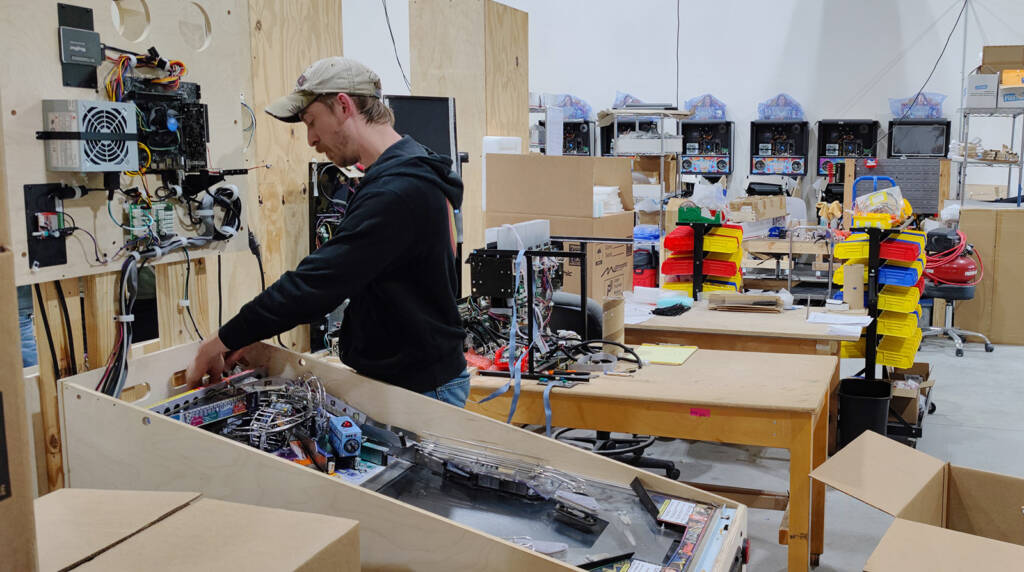
Testing completed playfield modules
There were six near-complete Weird Al games awaiting final testing before being packed and shipped to their buyers. P3 machines can be purchased as a bare base unit or with one of the company’s games pre-installed.
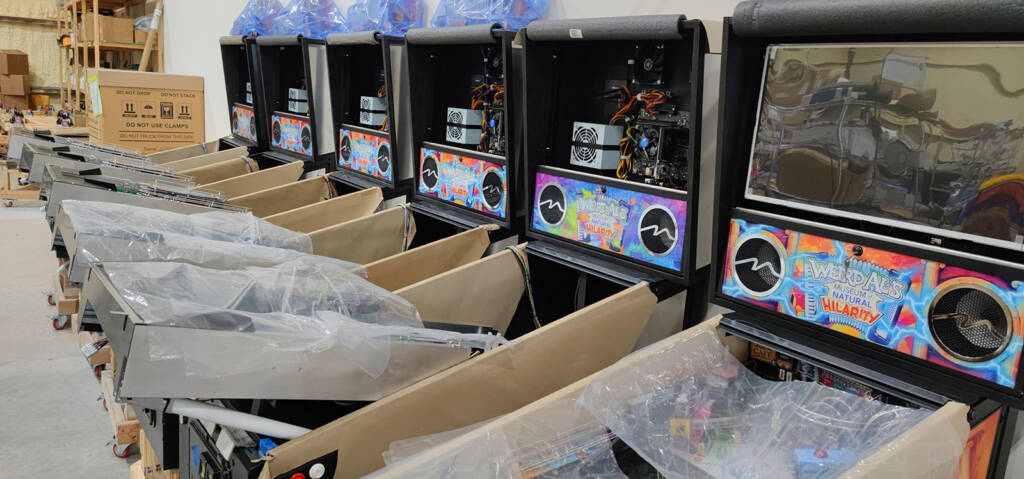
Near-complete P3 machines with the Weird Al game and branding installed
Gerry told us how he personally inspects and tests every P3 unit before it leaves the factory to make sure there are no issues with the game.
That concludes this tour of the Multimorphic facility in Round Rock, Texas. Many thanks to Gerry and the team for all their help at what was obviously a busy time for the company ahead of the Texas Pinball Festival. You can see the games on the Multimorphic stand in our extensive show report.
You can also hear Gerry talk about Multimorphic’s plans for future titles and how the company has grown over the years in our special bonus PINcast in conjunction with Pinball Magazine featuring interviews with leading pinball industry heads.
Continue reading...
Pinball News
Back in 2019 we paid a visit to the Multimorphic factory in Round Rock, Texas. Since then, much has changed, both with the company itself and with the pinball industry as a whole, but the intervening four years have been good for Multimorphic, with new games launched, new personnel on board, and the P3 platform becoming even more widely adopted.

The Multimorphic playfield and machine assembly area
As the business has grown, so has the company – literally. They now occupy around twice the factory space they did in 2019, taking over the adjacent unit for a woodworking shop, additional office space and an area used to display previous and current generations of the P3 pinball platform.
Pinball News has followed the evolution of the P3 right from its earliest days. Here are a few of those reports:
- The original report on the P3 prototype from 2012
- The news that the P3 was going into production
- Pre-order details and offers
- News of Dennis Nordman signing to design Lexy Lightspeed
- News about Lexy Lightspeed‘s development
- New cabinet and playfield module designs

The evolution of the P3 pinball platform
In addition to these early prototypes, the expanded space allows for ten P3 machines to be set up to showcase the range of games and playfield modules now available for the platform.

The P3 with various playfield modules and game packages
It’s worth noting how two of these machines featured prototype side panel RGB lighting strips around the backbox and cabinet artwork decals.

Backbox and cabinet RGB lighting effects
For protection, these animated LED strips fit under the artwork protectors available from the Multimorphic store to protect and secure the magnetic decals
When we visited, most of these P3s were about to be packed up and taken on a three-hour drive up to Frisco for the Texas Pinball Festival. There, they would be joined by two examples of the company’s latest release, Final Resistance.

Two of the latest Final Resistance games
The additional space is also home to a row of 3D printers which are used to produce some of the generic plastic parts used in the game such as speaker and fan housings, and various mounting brackets.
Multimorphic head, Gerry Stellenberg, told us it makes sense to 3D print some of their more common parts as they can be made on-demand, don’t take up storage space, and the price is often cheaper than ordering in small relatively quantities from plastics manufacturers more used to orders in the tens of thousands.

3D printers at work
The other part of the extended factory space is taken up with the woodworking shop where playfields, cabinets, backboxes, toppers and interior wooden parts are cut, along with other wooden parts such as the rotisseries used during playfield assembly.

Stacks of wood sheets in the woodworking shop
The CNC router cuts the sheets into the required parts.

The CNC router cutting playfields and cabinet parts
While they were once made of metal, the cabinets and backboxes for the P3 now use a more-traditional wooden construction, although they also feature a unique playfield slide system providing multiple points where the playfield can be rested or raised to access the underside.

Cabinets waiting to be painted
Completed cabinets and backboxes then head into the spray booth to be painted black.

The spray booth

Cabinets being painted black inside the spray booth
The area above the offices and showroom in the expansion unit is not wasted, as it is used for parts storage for the company’s expanding range of different titles.

Boxes of parts for games in storage on the upper floor
Meanwhile, back in the original factory space, construction of playfield modules and entire P3 machines is underway.

The playfield manufacturing area
Playfield modules for the company’s Weird Al’s Museum of Natural Hilarity game were being made during our visit.

Weird Al’s Museum of Natural Hilarity playfield modules
With a backorder time of up to 6 months for new game kits, there would be plenty more Weird Al game kits produced before Final Resistance goes into production, starting in May.

Manufacturing playfield modules

Assembling Multimorphic’s pop bumper modules

Applying playfield decals
Along with playfield modules, software and artwork, many new games also come with the option of a dedicated topper. The animated Weird Al topper has been especially well-received.

Completed Weird Al toppers
At one time, the base P3 machines were built by an external contractor with the individual game modules built in-house. Although the ability to make their own cabinets is a more recent development, they have been building the main playfield chassis (which slides into the cabinet) at the Multimorphic factory for several years.

Assembling complete P3 machines
The main playfield uses a modular system where different modules such as the main flippers, the playfield monitor, the upper flipper and the side targets all slide in on rails. This allows the correct functionality of each module to be tested in isolation before it is slid into position in the main playfield chassis to be tested again as part of the whole machine.

A rack of flipper modules

A rack of assembled walls & scoops modules
When the base machine has been assembled – together with any game module purchased at the same time – the P3 goes into testing using one of a pair of dedicated test rigs.

Testing completed playfield modules
There were six near-complete Weird Al games awaiting final testing before being packed and shipped to their buyers. P3 machines can be purchased as a bare base unit or with one of the company’s games pre-installed.

Near-complete P3 machines with the Weird Al game and branding installed
Gerry told us how he personally inspects and tests every P3 unit before it leaves the factory to make sure there are no issues with the game.
That concludes this tour of the Multimorphic facility in Round Rock, Texas. Many thanks to Gerry and the team for all their help at what was obviously a busy time for the company ahead of the Texas Pinball Festival. You can see the games on the Multimorphic stand in our extensive show report.
You can also hear Gerry talk about Multimorphic’s plans for future titles and how the company has grown over the years in our special bonus PINcast in conjunction with Pinball Magazine featuring interviews with leading pinball industry heads.
Continue reading...
